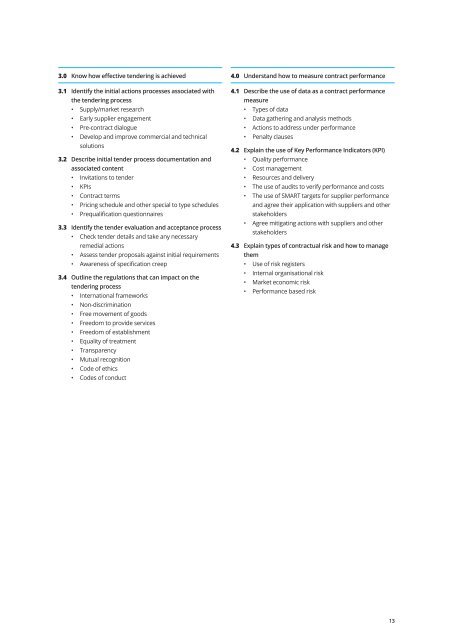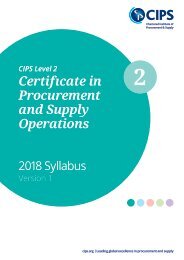CIPS Level 3 Certificate in Procurement and Supply Operations 2018 Syllabus
Create successful ePaper yourself
Turn your PDF publications into a flip-book with our unique Google optimized e-Paper software.
3.0 Know how effective tender<strong>in</strong>g is achieved<br />
3.1 Identify the <strong>in</strong>itial actions processes associated with<br />
the tender<strong>in</strong>g process<br />
• <strong>Supply</strong>/market research<br />
• Early supplier engagement<br />
• Pre-contract dialogue<br />
• Develop <strong>and</strong> improve commercial <strong>and</strong> technical<br />
solutions<br />
3.2 Describe <strong>in</strong>itial tender process documentation <strong>and</strong><br />
associated content<br />
• Invitations to tender<br />
• KPIs<br />
• Contract terms<br />
• Pric<strong>in</strong>g schedule <strong>and</strong> other special to type schedules<br />
• Prequalification questionnaires<br />
3.3 Identify the tender evaluation <strong>and</strong> acceptance process<br />
• Check tender details <strong>and</strong> take any necessary<br />
remedial actions<br />
• Assess tender proposals aga<strong>in</strong>st <strong>in</strong>itial requirements<br />
• Awareness of specification creep<br />
3.4 Outl<strong>in</strong>e the regulations that can impact on the<br />
tender<strong>in</strong>g process<br />
• International frameworks<br />
• Non-discrim<strong>in</strong>ation<br />
• Free movement of goods<br />
• Freedom to provide services<br />
• Freedom of establishment<br />
• Equality of treatment<br />
• Transparency<br />
• Mutual recognition<br />
• Code of ethics<br />
• Codes of conduct<br />
4.0 Underst<strong>and</strong> how to measure contract performance<br />
4.1 Describe the use of data as a contract performance<br />
measure<br />
• Types of data<br />
• Data gather<strong>in</strong>g <strong>and</strong> analysis methods<br />
• Actions to address under performance<br />
• Penalty clauses<br />
4.2 Expla<strong>in</strong> the use of Key Performance Indicators (KPI)<br />
• Quality performance<br />
• Cost management<br />
• Resources <strong>and</strong> delivery<br />
• The use of audits to verify performance <strong>and</strong> costs<br />
• The use of SMART targets for supplier performance<br />
<strong>and</strong> agree their application with suppliers <strong>and</strong> other<br />
stakeholders<br />
• Agree mitigat<strong>in</strong>g actions with suppliers <strong>and</strong> other<br />
stakeholders<br />
4.3 Expla<strong>in</strong> types of contractual risk <strong>and</strong> how to manage<br />
them<br />
• Use of risk registers<br />
• Internal organisational risk<br />
• Market economic risk<br />
• Performance based risk<br />
13
















